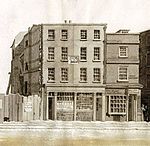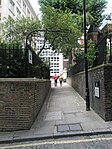St Martin Orgar

St Martin Orgar was a church in the City of London in Martin Lane, off Cannon Street. It is sometimes considered being one of the churches mentioned in the nursery rhyme "Oranges and Lemons". Most of the building was destroyed in the Great Fire of London in 1666, but the tower and part of the nave were left standing. The parish was merged with St Clement Eastcheap. The churchyard remained in use by the combined parish until 1853. The remains of the church were restored and used by French Protestants until 1820. Most of the remaining building was then pulled down, but the tower remained and was rebuilt in 1851 as the campanile of St Clement Eastcheap. A fragment of the churchyard of St Martin's remains to the south of the campanile.
Excerpt from the Wikipedia article St Martin Orgar (License: CC BY-SA 3.0, Authors, Images).St Martin Orgar
Martin Lane, City of London
Geographical coordinates (GPS) Address Nearby Places Show on map
Geographical coordinates (GPS)
| Latitude | Longitude |
|---|---|
| N 51.510827777778 ° | E -0.087527777777778 ° |
Address
Stafford Young Jones
Martin Lane 29
EC4R 0DJ City of London
England, United Kingdom
Open on Google Maps










